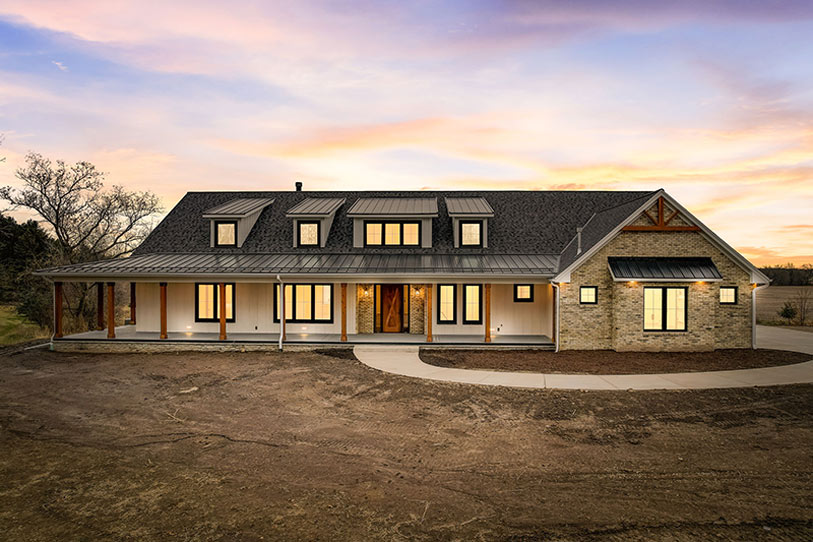Creating a dream home from scratch can be exciting and rewarding; but it can also be overwhelming. Custom home construction means designing a home especially for you, to fit your lifestyle, needs, and personal style.
Unlike buying a pre-built home, a custom house gives you complete control over every detail, from the layout to the materials used in its making. You can ensure that you realize the home of your dreams by following some time-tested tips.
In this blog we take a look at a few key tips that can help you move through the process of home construction with less stress and more excitement.
Key Takeaways
- Clearly envision your dream home, focusing on layout, design, and lifestyle preferences before consulting architects and builders.
- Choose a builder and architect with experience and good communication skills to bring your custom home to life.
- Incorporate sustainable materials, energy-efficient appliances, and insulation to reduce your home’s carbon footprint and save on utility bills.
- Design your home with practicality in mind, ensuring ample storage and functional spaces that suit your everyday – and future – needs.
- Regularly communicate with your builder and visit the site to ensure the construction aligns with your vision.
Here Are the Essential Tips for Custom Home Construction:
1. Define Your Vision Early On
Before starting the construction process, it is important to clearly envision the look and feel of your custom home. Take the time to consider your lifestyle, how many rooms you need, the layout, and the design aesthetic you want in your home. Would you prefer an open-plan living area or defined rooms? Maybe energy-efficient features interest you. How many bedrooms and bathrooms will you need?
Create a very specific wish list and identify your priorities; this will, in addition to clearly letting your builder and architect know about your vision, act as a yardstick for every decision during the custom home construction process. You may create a layout or collect images from magazines and websites for clear pictures of your dream home.
2. Find the Right Builder
Important decisions are made at the very outset of this custom home-building process. The first is choosing the right builder. Your builder is your partner in realizing this dream of yours, and it is important to find a builder who understands your needs, communicates well with you, and has a history of delivering quality custom homes.
First, research local builders who build custom homes. Inquire from friends or family members and surf online reviews or testimonials regarding their services. After shortlisting the potential builders, meet them to discuss your project in detail. Ask about past projects and how they handled any obstacle that came along during the process (it is unlikely there were none!), who meets with or communicates with their client – a site manager, project manager or the builder – and any other questions you may have. Pay attention to how they receive and respond to your questions. Don’t be intimidated.
The right builder makes the real difference in executing your custom home construction on time, within your budget, and to your complete satisfaction.
3. Determine a Realistic Budget
Construction of a custom home is an investment, and the budget should be realistically determined before the start of the project. Your budget should cover everything, from the cost of land and materials to labor costs, permit costs, and contingency expenses.
Again, work closely with your builder and architect to get an estimation of the costs involved, leaving room for contingencies. High-end materials, custom features, and technology upgrades tend to raise your costs astronomically. Be realistic about what you can afford, and don’t be afraid to scale certain elements of your home back if it means you can make sure others are a reality. An experienced builder will be able to help you understand where big dollars need to go and where cost savings are achievable without affecting the overall result.
Also, consider how additional costs, such as landscaping, utility hookups, or local government fees will affect the budget. A well-planned budget keeps your project on course and avoids stress during construction.
4. Selecting the Right Architect
While the builder handles the construction part, the architect is responsible for implementing your design ideas. A good architect will work with you to bring your functional and beautiful home idea to life.
When hiring an architect for your custom home build, find professionals who have experience with custom homes in the style of home you want to build. In these initial meetings, discuss your ideas in depth and ask the architect to contribute regarding practicality, energy efficiency, and design concerns.
5. Choose the Right Place
Where you build your house is just as important as how it’s built. From countryside seclusion to suburban development, location touches on many aspects, from daily life to property value. Your lifestyle plays a huge role in in choosing your home’s location. Are you purchasing a lot in a subdivision, already laid out and with access to utilities, or a parcel? Purchasing a parcel carries additional considerations, such as access to water and utilities, roads and services. In either case, educate yourself on any building requirements and restrictions before making the purchase to be sure you can build your dream home there. Conversely, if you already own the land, be sure there are no requirements or restrictions on the type of house you want to build before getting too far into architectural plans.
You can, however, ask your builder help you evaluate sites; they understand what you want and will be able to confirm the suitability of the lot for your design.
6. Plan for Energy Efficiency
Not only does adding energy efficiency to your custom home help the environment, but it can also save you money. From insulation to energy-efficient windows and appliances, there are some more ways to reduce a home’s carbon footprint and lower utility bills.
During custom home building, work with your builder and architect to explore sustainable material options, renewable energy sources such as solar panels, and water-saving fixtures.
Proper insulation, high-efficiency heating and cooling systems, and LED lighting further enhance your home’s energy performance.
7. Emphasize Functionality and Flow
While aesthetics are of great importance, functionality and flow at your house should be put first in the design of custom home construction. A perfectly designed home should be as functional as it looks, and practical for everyday living.
Consider how you will use each space and make decisions based on how they will be serving your needs. If you like cooking and having guests around, for example, consider making the kitchen roomy with a lot of counter space and seating. For families that have young children, consider the layouts of bedrooms and play areas.
Then, there is the flow between rooms to consider. The home should feel very cohesive; the transitions from one space to another should be logical. An open-plan layout can provide flexibility and flow in many homes, though some homeowners still would want more defined rooms. Everything is about striking a balance between form and function that works for you.
8. Don’t Skimp on Storage
One of the major regrets for many homeowners has to do with not putting enough storage into a home design. From closets to cabinetry to garage space, the amount of storage will determine how organized and clutter-free your home will remain.
Install plenty of built-in storage during custom home construction. Walk-in closets, pantry space, and custom shelving help maximize storage in just about every room. Consider less obvious areas like storage options under staircases, in the attic, or in the basement.
This will make your house functional and day-to-day life much easier.
9. Pay Attention to Lighting
Lighting can completely change the mood and functionality of your home. Good lighting enhances the aesthetic appeal of the home, both inside and outside, and also makes rooms more functional.
Consider adding an array of lighting options within your custom home construction planning: natural light, overhead fixtures, task, and accent lighting. Large windows, skylights, and glass doors will help one’s home be bright and full of inviting natural light.
Also, don’t forget to plan the lighting for key areas: kitchen, bathrooms, and outdoors. Layered lighting design also allows you to adjust the ambiance according to the time of day and activities.
10. Stay Involved in the Process
Finally, stay involved during the custom home-building process. You have hired the professionals for the execution of your dream, but communication is critical.
Stay updated with the progress by regularly communicating with your builder and architect. You must visit the site to assess the progress of construction and do not feel intimidated to ask questions or change when something feels out of order.
The benefit of being involved will be that the final product turns out to be what you had in mind, and also, any potential issues will be resolved right at the beginning.
Conclusion
Building a custom home requires extensive pre-planning, and getting the right team will make all the difference. Visit Renz Construction. From start to finish, they give each and every home their personal attention, handling every detail. There are no middlemen here. It is their passion to deliver the home of your dreams.

